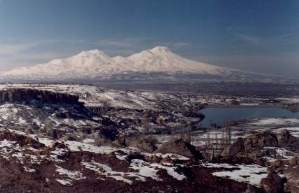|
|

|
|
Kirsehir and Nevsehir
|
Founded in ancient times. Kirsehir became n the Middle Ages. the center of the Ahi Brotherhood, a Moslem sect whose moral and social ideals played an important role in the spiritual and political life of Anatolian towns.Among Kirsehir's many fine Seljuk buildings are the Cacabey Mosque of 1272 (a former astrological observatory), the Alaeddin Mosque of 1230 and the Ahi Evran Mosque, near the tomb of the founder of the Ahi sect. Out of town on the road toward Kayseri, is the attractive Asik Pasa Mausoleum which was built during the period of Mongol rule, in 1333. The Kirsehir Archaeology Museum houses objects mostly from Kalehoyuk. Within the surroundings of Kaman, in the province of Kirsehir, is the important archaeological center of Kalehoyuk, still being excavated. Near Kalehoyuk in a center of Hatti and Hittite settlements is located one of the largest parks in Turkey - Mikasonmiya Ani Bahcesi, which contains 16,500 trees of 33 different species. |
|
The road to Nevsehir and Cappadocia passes through Hacibektas, the town where Haci Bektas Veli settled and established his Bektas Sufi order in the 14th century. The dervishes who followed the sect's tenets of love and humanism were housed in the monastery which includes a mausoleum and mosque. The complex is now a museum open to the public. Honey and rose-colored onyx, plentiful in the region, were used by disciples of this order and are known as Hacibektas stone. In town, there are many exquisite onyx souvenirs for sale. It is also worth stopping to wander through the interesting Archaeology and Ethnography Museum. |
| Nevsehir, a provincial capital, is the gateway to Cappadocia. In the town itself, the hilltop Seljuk castle, perched on the highest point in the city, and the Kursunlu Mosque, built for the Grand Vizier Damat Ibrahim Pasha, are among the remaining historical buildings. The mosque forms part of a complex of buildings which includes a medrese, a hospice and a library. An ablution fountain in the courtyard still bears its original inscription. The Nevsehir Museum displays local artifacts. | Violent eruptions of the volcanoes Mt. Erciyes (3,916 meters) and Mt. Hasan (3,268 meters) three million years ago, covered the plateau surrounding Nevsehir with tufa, a soft stone comprised of lava, ash and mud. The wind and rain have eroded this brittle rock and created a spectacular surrealist landscape of rock cones, capped pinnacles and fretted ravines, in colors that range from warm reds and golds to cool greens and greys.Goreme National Park, known in Roman times as Cappadocia, is one of those rare regions in the world where the works of man blend unobtrusively into the natural surroundings. |

|
|---|---|
| Dwellings have bee hewn from the rocks as far back as 4,000 B.C. During Byzantine times, chapels and monasteries were hollowed out of the rock their ochre-toned frescoes reflecting the hues of the surrounding landscape. Even today troglodyte dwellings in roc cones and village houses of volcanic tufa merge harmoniously into the landscape. |

|

|


This site prepared by Tayfun Kalyoncu on 28.02.1997 and last updated on 01.05.1999.
For any comments and suggestion please send an e-mail using the form at page mailform.html